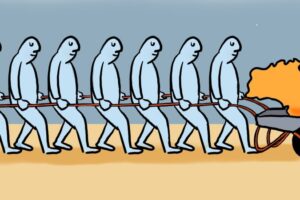COVID had a silver lining, and it could be contagious

Save articles for later
Add articles to your saved list and come back to them any time.
Australia is in the midst of an upside-down jobs miracle. The regions have lower unemployment than big cities; the share of young people with a job is growing more quickly than for older workers; those with little education are finding work; and the ranks of the long-term unemployed are in sharp decline.
Despite a turbulent period of high inflation and rising interest rates, unemployment has been at 50-year lows, around 3.5 per cent, since the middle of last year. The jobless rate is now lower than 4 per cent across all states and territories for the first time since monthly figures began in 1978.
Not long ago, figures like that seemed impossible. When I began work as an economics journalist in 1999, unemployment had been stuck above 7 per cent for most of the decade. I recall the upbeat headlines in 2003 when the rate fell below 6 per cent for the first time in 13 years.
But the encouraging employment milestones of 2023 have received surprisingly little attention. Debate about unemployment was a dominant theme of federal politics throughout the 1970s, 1980s and 1990s. But during the past two decades political attention has shifted.
The current jobs bonanza is underpinned by the effects of the massive economic stimulus unleashed during the COVID disruptions. After a gut-wrenching spike in unemployment at the onset of the crisis in 2020, the jobs market bounced back with gusto. The long pause in migration due to COVID restrictions helped turbocharge demand for local labour.
This has been especially good for groups that usually lag in the employment stakes.
Take Australia’s regions. Typically, our capital cities have lower unemployment than the rest of the state – often by a considerable margin. But, at the moment, Sydney’s unemployment rate is higher than the rest of NSW, Melbourne’s rate is higher than the rest of Victoria, and Brisbane’s rate is higher than the rest of Queensland.
Some regional cities hit hard in the past by the decline of manufacturing are doing especially well.
In Wollongong, the third-biggest city in NSW, the jobless rate was stuck above 6 per cent for most of the decade before COVID-19. But average annual unemployment for the past 12 months has been just 2.7 per cent, well below Sydney’s rate.
It’s a similar story in Victoria’s second-biggest city, Geelong, where the average annual rate of unemployment was 2.4 per cent last month. That’s down from over 6 per cent in 2019.
Younger, less educated workers are also doing disproportionately well. Analysis by Melbourne University professor Jeff Borland, an expert on the Australian labour market, shows the proportion of 15-24 year-olds with a job has grown at a much faster rate since the COVID crisis than for those aged 25-64 years.
Employment growth since 2019 has also been faster for those with a below-bachelor level post-school qualification (up 1.3 percentage points) than it has been for those with a bachelor degree or above (up 1 percentage point).
The Reserve Bank points out the participation of young people in the labour force is “around its highest rate in recent decades” and youth unemployment is at 40-year lows.
The post-lockdowns period has delivered record-breaking results for women workers. Last month, the share of the female population with a job hit an all-time high (60.4 per cent) as did the share of women full-time workers (39 per cent) and the proportion of hours worked by women (42.5 per cent of the total). To cap all that, the unemployment rate for women reached a record low of 3.36 per cent.
The recent improvement in long-term unemployment is another bright spot – the number of Australians out of work for a year or more was at a 14-year low last month. Research shows long-term unemployment is a major drag on wellbeing, so that improvement will deliver a substantial benefit to the community.
Borland says these trends underscore the “equity benefits” that come with a strong labour market. It is a potent tool to improve economic inclusion. Although, the quality of many low skill jobs, and sluggish wages growth remain a problem.
The jobs recovery that followed the upheavals of COVID-19 has another powerful legacy – it shows Australia should aim for lower jobless rates than has been considered acceptable in the past.
During the 2010s, economic officials assumed that if unemployment in Australia fell much below 5 per cent it would risk excessive wage growth and inflation. But the COVID era has proved much lower levels are sustainable – the unemployment rate has now been below 4 per cent for more than a year and there’s no evidence of a damaging wages blowout.
Australia has probably tolerated an unnecessarily high unemployment rate for much of this century.
Borland calls this lesson a “silver lining” of the pandemic. “The education we’re getting is that the unemployment rate we can aim for is lower than we previously thought,” he says.
That’s great news for workers – the upside-down jobs miracle could be permanent.
The Opinion newsletter is a weekly wrap of views that will challenge, champion and inform your own. Sign up here.
Most Viewed in Business
From our partners
Source: Read Full Article
